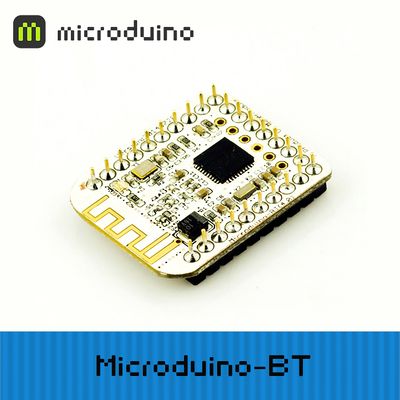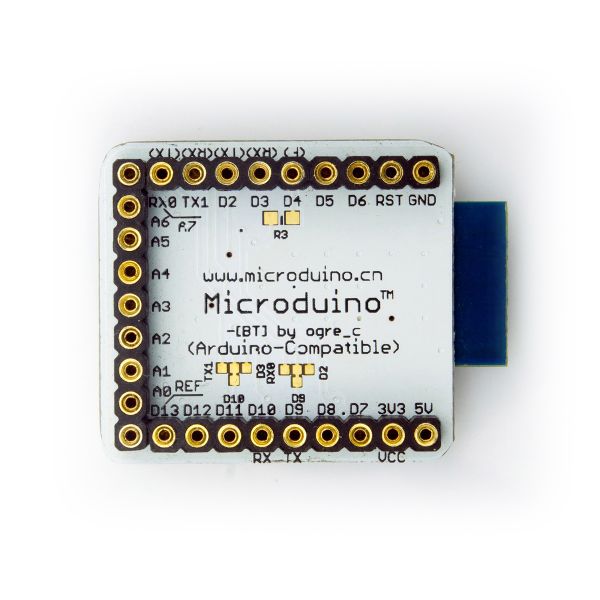Difference between revisions of "Microduino-【BT】"
From Microduino Wiki
| Line 3: | Line 3: | ||
|- | |- | ||
| | | | ||
| − | [[ | + | [[File:Microduino-bt-rect.jpg|400px|thumb|right|Microduino-Shield BT4.0]] |
| − | + | Microduino-Shiedl BT4.0 module is a plug-in device that supports Bluetooth 4.0 low energy standard. | |
| + | Microduino-Shield BT4.0 module is a bluetooth serial port transparent transmission module, use the 27 PIN standard Microduino interface, support the Arduino board and derivatives, such as Microduino core. | ||
| + | The module is designed by player ogre_c. | ||
| − | + | ==Features== | |
| + | *Microduino-Shield BT4.0 use U type 27 PIN interface of Microduino, combines with other Microduino modult to use; | ||
| + | *Microduino-Shield BT4.0 use the HM-10 BLE as the bluetooth core module; | ||
| + | *TI CC2540 chip with 256Kb space; | ||
| + | *Support AT command,the serial baud rate, device name, matched passward can be changed, easy to use; | ||
| + | *Small, cheap, stackable, opened platfrom; | ||
| + | *Open source hardware circuit design, compatible with the Arduino IDE development environment for programming; | ||
| + | *Defines unified interface Microduino specification and contain rich peripheral modules. Set up the quick connection with other Microduino modules and sensors easily and flexibly. | ||
| + | *2.54 pitch row female connector for easy integration into breadboard. | ||
| + | |||
| + | ==Specifications== | ||
| + | *Communication forms: serial passthrough; | ||
| + | *Power:+3.3VDC 50mA; | ||
| + | *Bluetooth protocol:Bluetooth Specification V4.0 BLE; | ||
| + | *Service:Central & Peripheral UUID FFE0,FFE1; | ||
| + | *Working frequency:2.4GHz ISM band; | ||
| + | *Modulation method:GFSK(Gaussian Frequency Shift Keying); | ||
| + | *Transmission power:≤4dBm; | ||
| + | *Sensitivity:≤-84dBm at 0.1% BER; | ||
| + | *Transmission rate: | ||
| + | **Asynchronous: 6 kbps; | ||
| + | **Synchronous: 6 kbps; | ||
| + | *State indicator: | ||
| + | **Two states: | ||
| + | ***Flashing means module powered, no matched. | ||
| + | ***Lighting means module has matched and can start communication. | ||
| + | **You can know the module's state by the indicator, easy to use. | ||
| + | |||
| + | ==Documents== | ||
| + | Eagle PCB '''[[File:Microduino-BT Shield.zip]]''' | ||
| + | |||
| + | ===Main component=== | ||
| + | **HM-10 Bluetooth module datasheet:'''[[File:Bluetooth40 cn.pdf]]''','''[[File:Bluetooth40 en.pdf]]''' | ||
| + | **cc2540_datasheet:'''[[File:Cc2540 datasheet.pdf]]''' | ||
| + | |||
| + | ==Development== | ||
| + | ===Seril configuration=== | ||
| + | *Default serial configuration: | ||
| + | **Baud rate: 9600 | ||
| + | **No check | ||
| + | **Data bits: 8 | ||
| + | **Stop bit: 1 | ||
| + | *Serial port on Arduino IDE's serial monitor: | ||
| + | **Set to:"No line terminator"、"9600baud" | ||
| + | *For other serial debug software: | ||
| + | **Baud rate: 9600 | ||
| + | **No check | ||
| + | **Data bits: 8 | ||
| + | **Stop bit: 1 | ||
| + | |||
| + | *Use the RX0, TX1 as the default communication pin between Microduino Shield BT4.0 and Core module, so can't directly superimposed with Microduino FT232R. | ||
| + | |||
| + | ===Use PC to debug=== | ||
| + | *Use serial directly: | ||
| + | **No need superimpose the FT232 directly, cross connect the FT232 and Shield BT4.0's RX0,TX1. | ||
| − | + | ===Use FT232R、Core download and debug=== | |
| + | *Use default jumper (RX0、TX1): | ||
| + | **Unplug the Microduino Shield BT4.0 during download program; | ||
| + | *If you want to change the jumper cables to meet your requirement:cut the connection between two intermediate of the pad and RX0/TX1, and then connect them to D2, D3(or D9、D10). | ||
| + | **If changed the jumper, need the change the serial connection between Microduino Shield BT4.0 and Core module, change the connection "TX-RX0、RX-TX1" to following: | ||
| + | ***TX-D2、RX-D3 (For Core+'s Serial1) | ||
| + | ***TX-D9、RX-D10 (all SoftwareSeria libray to resolve) | ||
| − | |||
| − | |||
| − | |||
| − | |||
| − | |||
| − | |||
| − | |||
| − | |||
| − | |||
| + | ===Pin description=== | ||
| + | |||
| + | [[File:BT-Pinout-1.jpg|800px|thumb|center|Microduino-BT-Pinout-t]] | ||
| + | [[File:BT-Pinout-2.jpg|800px|thumb|center|Microduino-BT-Pinout-b]] | ||
| + | {|class="wikitable" | ||
| + | ! rowspan="1" | HM-10 Pin || Microduino Pin || Function | ||
| + | |- | ||
| + | | TX|| RX0(orD2/D9) || serial send pin (TTL),connect Core's RXD | ||
|- | |- | ||
| − | | | + | | RX || TX1(orD3/D10) || serial receive pin (TTL),connect Core's TXD |
| + | |} | ||
| − | |||
| − | |||
| − | |||
| − | |||
| − | |||
| − | |||
| − | |||
| − | |||
| − | |||
| − | |||
| − | |||
| − | + | *Support AT command to configure and control:'''[[File:Bluetooth40 cn.pdf]]''','''[[File:Bluetooth40 en.pdf]]''' | |
| − | |||
| − | |||
| − | |||
| − | |||
| − | |||
| − | == | + | ==Application== |
| − | + | ===Download progrm=== | |
| − | + | Test program:'''[[File:BLE debug uart1.zip]]''','''[[File:BLE LightBlue time.zip]]''' | |
| − | |||
| − | |||
| − | |||
| − | |||
| − | |||
| − | |||
| − | + | ===Shield BT4.0 pass-through data to IOS devices=== | |
| − | + | *Prepared hardware:Microduino FT232R, Microduino Core, Microduino Shield BT4.0, supported Bluetooth 4.0 devices (iPhone4s upper,iPod touch 5 upper,iPad 3 upper,iPad mini upper); | |
| + | *Prepared software: Arduino IDE (1.0 release and upper), Microduino test program (Arduino part), download LightBlue from App Store; | ||
| + | *Start Arduino IED,open the Microduino test program, board type select "Microduino Core (Atmega328P@16M,5V)", download directly; | ||
| + | *Start to set the IOS device: | ||
| + | **start the bluetooth function on IOS device; | ||
| + | **Open LightBlue; | ||
| + | **In "Central" tab find the "HMSoft", then set "Service"-"Characteristics"; | ||
| + | **Then you can see the debugging window, click the "Start Notify". | ||
| + | *ASCII data can be seen displayed: "BLE, Time: xxx" after connection success, where xxx is the Core and Shield BT4.0's running time in seconds. | ||
| − | |||
| − | |||
| − | |||
| − | |||
| − | |||
| − | |||
| − | |||
| − | |||
| − | |||
| − | |||
| − | |||
| − | |||
| − | |||
| − | |||
| − | |||
| − | |||
| − | |||
| − | |||
| − | |||
| − | |||
| − | |||
| − | |||
| − | |||
| − | |||
| − | |||
| − | |||
| − | |||
| − | |||
| − | |||
| − | |||
| − | |||
| − | |||
| − | |||
| − | |||
| − | |||
| − | |||
| − | |||
| − | |||
| − | |||
| − | + | ===Use Core+'s uart1 to debug Shield BT4.0=== | |
| − | + | *Prepared hardware:Microduino FT232R, Microduino Core+, Microduino Shield BT4.0; | |
| − | + | *Prepared software:Arduino IDE (1.0 release and upper), Microduino test program (Arduino part); | |
| − | + | *Other configuration:Suppose the player has changed the jumper which change the serial to D2、D3; | |
| + | *Start Arduino IED, open Microduino test program, select the board type "Microduino Core (Atmega328P@16M,5V)", download directly; | ||
| + | *Check the serial communication: | ||
| + | **Open the serial monitor,send uppercase “AT”(no \r\n appened), if return “OK”,that means matched. | ||
| − | |||
| − | |||
| − | |||
| − | |||
| − | |||
| − | |||
| − | |||
| − | |||
| − | |||
| − | |||
| − | + | ===Microduino-Shield BT4.0 simple testing=== | |
| − | + | *[http://viewc.com/p/296 Microduino-Shield BT4.0 simple testing] from @颜火山 | |
| − | * | ||
| − | + | ==Bug== | |
| − | |||
| − | |||
| − | |||
| − | |||
| − | |||
==History== | ==History== | ||
| − | + | *On June 5, 2013, the second time proofing is completed, changed its name to the "Microduino - (BT)" and added the third optional serial port - UART1, divided into 2 version, version 2.1, a module used for HM09;A 4.0 version, module used for HM10. | |
| + | *On May 10, 2013, the board is completed. | ||
|- | |- | ||
| Line 134: | Line 131: | ||
[[file:Microduino-【BT】-b.jpg|thumb|600px|center|Microduino BT 4.0 Back]] | [[file:Microduino-【BT】-b.jpg|thumb|600px|center|Microduino BT 4.0 Back]] | ||
| − | + | ==Video== | |
|} | |} | ||
Revision as of 05:37, 21 February 2014
| Language: | English • 中文 |
|---|
|
Microduino-Shiedl BT4.0 module is a plug-in device that supports Bluetooth 4.0 low energy standard. Microduino-Shield BT4.0 module is a bluetooth serial port transparent transmission module, use the 27 PIN standard Microduino interface, support the Arduino board and derivatives, such as Microduino core. The module is designed by player ogre_c. ContentsFeatures
Specifications
DocumentsEagle PCB File:Microduino-BT Shield.zip Main component
DevelopmentSeril configuration
Use PC to debug
Use FT232R、Core download and debug
Pin descriptionFile:BT-Pinout-1.jpg Microduino-BT-Pinout-t File:BT-Pinout-2.jpg Microduino-BT-Pinout-b
ApplicationDownload progrmTest program:File:BLE debug uart1.zip,File:BLE LightBlue time.zip Shield BT4.0 pass-through data to IOS devices
Use Core+'s uart1 to debug Shield BT4.0
Microduino-Shield BT4.0 simple testing
BugHistory
| |||||||||
PicturesVideo |


